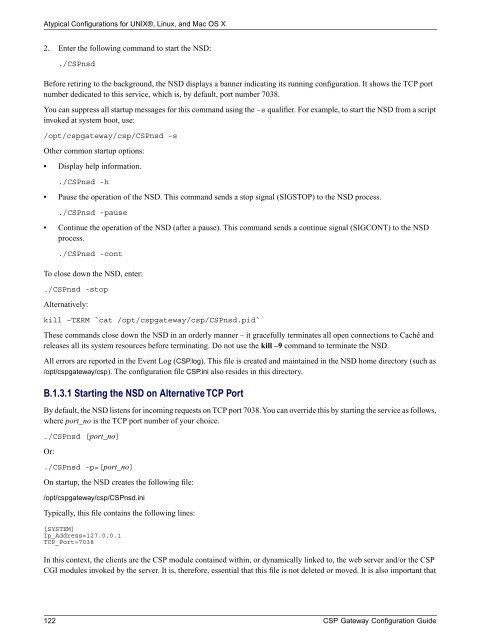CSP Gateway Configuration Guide - InterSystems Documentation
CSP Gateway Configuration Guide - InterSystems Documentation
CSP Gateway Configuration Guide - InterSystems Documentation
You also want an ePaper? Increase the reach of your titles
YUMPU automatically turns print PDFs into web optimized ePapers that Google loves.
Atypical <strong>Configuration</strong>s for UNIX®, Linux, and Mac OS X<br />
2. Enter the following command to start the NSD:<br />
./<strong>CSP</strong>nsd<br />
Before retiring to the background, the NSD displays a banner indicating its running configuration. It shows the TCP port<br />
number dedicated to this service, which is, by default, port number 7038.<br />
You can suppress all startup messages for this command using the -s qualifier. For example, to start the NSD from a script<br />
invoked at system boot, use:<br />
/opt/cspgateway/csp/<strong>CSP</strong>nsd –s<br />
Other common startup options:<br />
• Display help information.<br />
./<strong>CSP</strong>nsd -h<br />
• Pause the operation of the NSD. This command sends a stop signal (SIGSTOP) to the NSD process.<br />
./<strong>CSP</strong>nsd -pause<br />
• Continue the operation of the NSD (after a pause). This command sends a continue signal (SIGCONT) to the NSD<br />
process.<br />
./<strong>CSP</strong>nsd -cont<br />
To close down the NSD, enter:<br />
./<strong>CSP</strong>nsd -stop<br />
Alternatively:<br />
kill –TERM `cat /opt/cspgateway/csp/<strong>CSP</strong>nsd.pid`<br />
These commands close down the NSD in an orderly manner – it gracefully terminates all open connections to Caché and<br />
releases all its system resources before terminating. Do not use the kill –9 command to terminate the NSD.<br />
All errors are reported in the Event Log (<strong>CSP</strong>.log). This file is created and maintained in the NSD home directory (such as<br />
/opt/cspgateway/csp). The configuration file <strong>CSP</strong>.ini also resides in this directory.<br />
B.1.3.1 Starting the NSD on Alternative TCP Port<br />
By default, the NSD listens for incoming requests on TCP port 7038. You can override this by starting the service as follows,<br />
where port_no is the TCP port number of your choice.<br />
./<strong>CSP</strong>nsd [port_no]<br />
Or:<br />
./<strong>CSP</strong>nsd -p=[port_no]<br />
On startup, the NSD creates the following file:<br />
/opt/cspgateway/csp/<strong>CSP</strong>nsd.ini<br />
Typically, this file contains the following lines:<br />
[SYSTEM]<br />
Ip_Address=127.0.0.1<br />
TCP_Port=7038<br />
In this context, the clients are the <strong>CSP</strong> module contained within, or dynamically linked to, the web server and/or the <strong>CSP</strong><br />
CGI modules invoked by the server. It is, therefore, essential that this file is not deleted or moved. It is also important that<br />
122 <strong>CSP</strong> <strong>Gateway</strong> <strong>Configuration</strong> <strong>Guide</strong>

















